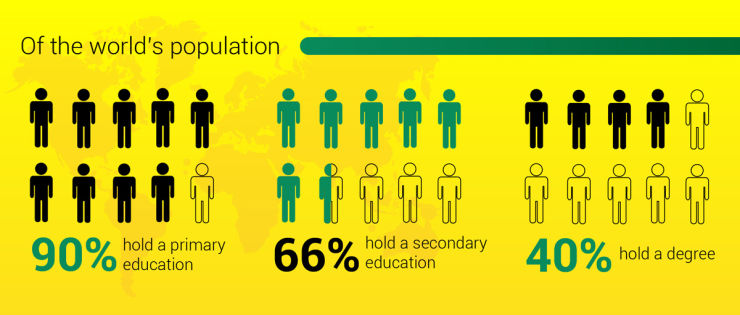
The four factors changing the university landscape forever
The traditional university experience has not changed for decades until online learning came along. Now it’s not just the location that’s changing, but also the curriculum model
Those that have been able to receive some sort of university education can count themselves lucky. Statistics show that around 90% of the world’s population had completed a primary education in 2020, whereas only 66% had attained a secondary education. The numbers were even lower in tertiary education, with around 40% of the global population having attained some kind of degree.

Coming out of university with a gown on your back, a mortarboard above your head, and a rolled-up certificate to tell everyone that the three or more letters behind your name now means that you are more employable than the 60% who were unable to do so, is not really enough anymore.
So, what exactly do those three letters of a BBA or MBA really mean in the greater scheme of things? For an employee, it means a better job and the chance of promotions and pay raises. For the employer, it means employing more competent employees that can really get the job done and significantly contribute to the bottom line of the company.
Sounds like a win-win situation for both parties right? A couple of decades ago people would have said yes. But now, as the famous musician, Bob Dylan once wrote, “The times they are changing.”
Universities and learners must shift to skills-based learning
To really prepare university graduates for the real working world, it’s no longer enough to teach basic theory. That ship has sailed. Modern universities such as Nexford, which were born online, and with a very different mission statement that works on the premise that a competency-based curriculum is the real win-win situation for learners and their current and possibly future employees.
In its very basic form, it means that the employer gets an employee that is able to hit the ground running with no time-consuming hand-holding, or expensive on-the-job training. The world is moving very fast as we all know, so people need the skills to get ahead and stay ahead of the chasing pack.
But it’s not just the curriculum that is changing, it’s also the location of universities. The pandemic shone a spotlight on the need for more educators to shift their teaching model from traditional brick and mortar institutions to online learning. This leap has had a massive socio-economic impact on prospective students. Those learners in remote and what would be largely regarded as poorer areas of the world, now have access to quality education without having to endure the costs of travel or leave a job in the hope of obtaining a better one in the future.
Learn how to develop the most in-demand skills for your future career!
Discover how you can acquire the most in-demand skills with our free report, and open the doors to a successful career.
The time for a dramatic change in university education is now!
Time waits for no man or woman and as such, to ensure that they remain relevant and attractive to modern-day learners, universities have had to internalize and take a massive look at how they position themselves in the marketplace. That has meant looking at four dramatic changes that have to be undertaken. If they don’t adapt, they will die.

1. Learning remotely
Businesses have in the last two years come to the stark realization that attracting top talent from all over the world has nothing to do with geography anymore. Online remote working has become the norm and is spawning a new generation of workers that are able to occupy remote jobs at big companies outside their borders. These are opportunities that form a type of global grid.
If we can work from anywhere, it’s obvious that we should be able to learn from anywhere. This education model helps save learners on travel costs, location costs of having to live on- or off-campus, or having to apply for a travel visa. But it’s not just a learn from anywhere approach that is taking the higher learning industry out of its comfort zone, but rather a learn from everywhere approach. The classroom is now wherever people are.
2. Replacing lectures with project based learning
There is theory and then there is practice. We should all know the difference and what that means for the productivity of a company. Gone are the days when lecturers stood in front of a bored classroom of learners preaching the gospel according to the textbook. Competency-based learning is now leading the way.
Learners need to learn about and tackle real-world challenges faced by top companies through case studies and create marketing campaigns off the back of that newfound knowledge. This provides learners with the practical skills required to succeed both now and in the future.
The facts speak for themselves of just how outdated lectures really are. Universities that have not been able to effectively make the switch to modern online learning are rapidly going out of business. Primarily because learners are realizing that online learning is more cost-effect than having someone expound information that they can get cheaper elsewhere.
Our brains don’t learn by listening as shown by the Ebbinghaus forgetting curve below. Real learning relies on principles such as spaced learning, emotional learning, and the application of knowledge. The educational establishment has gradually accepted this method, known as ‘fully active learning’. There is evidence that it not only improves learning outcomes but also reduces the education gap with socio-economically disadvantaged students.

There is evidence that it not only improves learning outcomes but also reduces the education gap with socio-economically disadvantaged students.
3. Imparting skills that keep pace with a changing world
According to a recent survey, 96% of Chief Academic Officers at universities think they are doing a good job preparing young people for the workforce. Less than half (41%) of college students and only 11% of business leaders shared that view.
What is required is relevant skills that stay up-to-date in an ever-changing world where the job market is evolving month by month and not every year as was many years ago. A degree should prepare the learner for this world, not yesterday’s. It should be fit for purpose, maximize their employability and open up future opportunities. If not, these individuals are set to become a dinosaur in the job market.
Proof of which is in the past, a CTO was only responsible for keeping the lights on when it comes to IT. Today, that role now demands that this individual upskill to ensure that they now have the ability to lead an enterprise’s digitization strategy. This involves a skills enhancement that allows them to effectively create a roadmap outlining the application of digitized tools and techniques to enhance business processes.
San Francisco-based Minerva University, which shares a founder with the Minerva Project, has broken down competencies such as critical thinking or creative thinking into foundational concepts and habits of mind. It teaches these over the four undergraduate years and across disciplines, regardless of the major a student chooses to pursue.
Lots of questions. But where do the answers lie and what do universities need to do to remain relevant and allow them to breed successful degreed individuals. It is widely though that they need to align with professional business organizations, research labor market data and examine official employability frameworks, such as Common Employability Skills and the Connecting Credentials Framework, to develop industry-relevant and future-focused competencies. The result? An immersive, competency-based education (CBE) experience that puts a learner’s chosen career at its heart.
Are you ready to take your career to the next level?
Nexford's Career Path Planner takes into account your experience and interests to provide you with a customized roadmap to success.
Receive personalized advice on the skills and qualifications you need to get ahead in areas like finance, marketing, management and entrepreneurship.
4. Solving real-world business challenges instead of sitting irrelevant exams
The business world does not operate out of a classroom, nor seemingly a boardroom anymore for that matter. Decisions are happening in real-time and so people need to be skilled in ways to react to rapid change for better business outcomes. That means that the skills you may have learned a decade or so ago, are pretty much redundant right now as well as the piece of paper that you earned post-graduation.
Many US universities, such as Nexford and Harvard have chosen to reject old-school physical examinations in favor of skills-based learning that not only better assess learning outcomes, but actually improve on them. Case studies and real-world business challenges, which entails both formal and informal evaluations through the learning journey, encourage students to actually improve their performance rather than just have it evaluated.
Education reform requires looking at the root cause of some of its current problems. We need to look at what is being taught when it is being taught and in what location. Those institutions that are ready to address these fundamental issues will succeed in truly transforming higher education.
Ready to take the next step? Download our brochure or book a call with our Nexford Advisors!

Mark is a college graduate with Honours in Copywriting. He is the Content Marketing Manager at Nexford, creating engaging, thought-provoking, and action-oriented content.
Join our newsletter and be the first to receive news about our programs, events and articles.